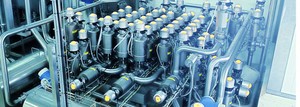Mixproof Valves 101: Benefits & Applications
Featured Product from Burkert Fluid Control Systems

Working Principles - Understanding a mixproof valve’s design, its working principles and benefits is critical to recognizing potential applications. A mixproof valve has two seats within the valve versus the traditional single seat. This allows for fluid separation. In the case of a leak, there is an exit area between the two seats. This creates a positive method for preventing the two different fluids from contaminating one another.
Mixproof valves have two independent plug seals to separate the fluids. The space between these seals forms a leakage chamber at atmospheric pressure during all working conditions. Leakage is not common with mixproof valves; however, if leakage does occur, product flows into a leakage chamber and leaves through the bottom outlet, making detection easier
When the valve is open, the leakage chamber is closed. The product then flows from one line to the other. The radial seal design of the valve ensures that virtually no product spillage occurs during valve operation. It is possible to adapt valve configuration to get optimum cleaning and water hammer protection as per the requirements of individual process specifications.
The mixproof valve’s design of two independently controlled valve stems helps ensure that two different products cannot mix. This makes mixproof valves ideal for large-scale food, beverage, dairy and other high-purity manufacturing facilities that produce several products at the same time.
Benefits - Designed to optimize resources, mixproof valves’ ability to perform dual functions simultaneously is helpful for food, beverage and dairy manufacturers. Integrating mixproof valve technology leads to decreased downtime and increased production. Maintenance and service are relatively simple, and a long product life span is common, with little investment required for spare part replacement.











